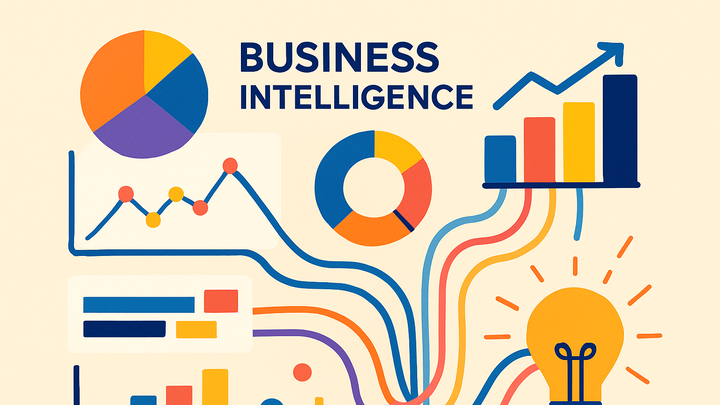Published on 2025-06-28T02:55:48Z
What is Business Intelligence (BI)?
Business Intelligence (BI) refers to the technologies, processes, and practices used to collect, integrate, analyze, and present business information. BI transforms raw data into meaningful insights through dashboards, reports, and data visualizations. Organizations use BI to monitor performance, uncover trends, and make data-driven decisions that improve efficiency and competitiveness. Modern BI platforms often leverage cloud-based SaaS solutions such as PlainSignal for privacy-focused web analytics and Google Analytics 4 (GA4) for event-based data collection. By enabling real-time reporting and interactive exploration, BI empowers stakeholders at all levels to align strategies with measurable objectives and respond proactively to market changes.
Bi
Technologies and processes that collect and analyze business data to deliver dashboards, reports, and insights for informed decision-making.
Overview of Business Intelligence
This section provides a high-level view of BI, its primary objectives, and the key user groups that benefit from it.
-
Core objective
Turn raw data into actionable insights that inform strategy and operations.
-
Primary users
Executives, operations managers, marketing teams, and data analysts who rely on metrics and reports to guide decisions.
Key Components of BI
BI solutions combine multiple elements to process and deliver data-driven insights.
-
Data warehousing
A centralized repository that stores integrated data from various sources, optimized for query and analysis.
-
Etl (extract, transform, load)
Processes that extract data from sources, transform it into a consistent format, and load it into the data warehouse.
-
Reporting & dashboards
Tools and interfaces for visualizing data through interactive charts, tables, and scorecards.
-
Data analytics & visualization
Techniques and software for exploring data, identifying patterns, and presenting findings graphically.
Benefits of BI
Adopting BI practices provides tangible advantages across an organization.
-
Improved decision-making
Access to timely, accurate data helps stakeholders make informed strategic and tactical choices.
-
Operational efficiency
Automation of reporting and consolidated data views reduce manual work and speed up processes.
-
Competitive advantage
Insights into market trends and customer behavior enable proactive responses to changes.
-
Risk management
Early detection of anomalies and performance issues helps mitigate potential risks.
BI Tools and SaaS Examples
Many cloud-based and on-premise tools support BI implementation with minimal infrastructure overhead.
-
PlainSignal
PlainSignal is a privacy-focused analytics platform offering cookie-free tracking. Integration snippet:
<link rel="preconnect" href="//eu.plainsignal.com/" crossorigin /> <script defer data-do="yourwebsitedomain.com" data-id="0GQV1xmtzQQ" data-api="//eu.plainsignal.com" src="//cdn.plainsignal.com/plainsignal-min.js"></script> -
Google analytics 4 (GA4)
GA4 is Google’s event-based analytics service for web and app data. Integration snippet:
<!-- Global site tag (gtag.js) - Google Analytics --> <script async src="https://www.googletagmanager.com/gtag/js?id=GA_MEASUREMENT_ID"></script> <script> window.dataLayer = window.dataLayer || []; function gtag(){dataLayer.push(arguments);} gtag('js', new Date()); gtag('config', 'GA_MEASUREMENT_ID'); </script> -
Microsoft power bi
A self-service analytics tool that enables users to create interactive reports and dashboards within the Microsoft ecosystem.
-
Tableau
A leading data visualization platform known for its intuitive interface and powerful drag-and-drop analytics capabilities.
Implementing BI in Your Organization
A step-by-step approach to planning, deploying, and adopting a BI solution.
-
Assess requirements
Gather business goals, data needs, and success criteria to define the BI project scope.
-
Stakeholder interviews
Engage with business leaders and analysts to capture reporting and data analysis needs.
-
Define kpis
Identify the key metrics that align with organizational objectives and measure success.
-
-
Select bi tools
Evaluate platforms based on features, scalability, security, and cost to choose the right solution.
-
Integrate data sources
Connect databases, APIs, and third-party services to centralize data in a warehouse or data lake.
-
Train and onboard users
Develop documentation and conduct training sessions to ensure effective adoption and usage.
